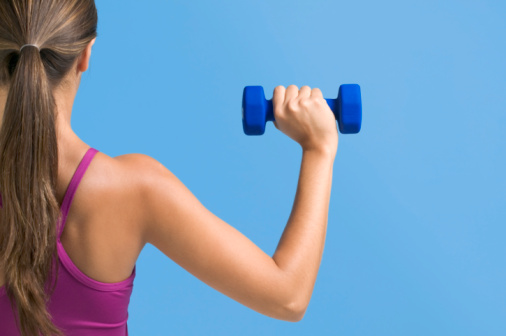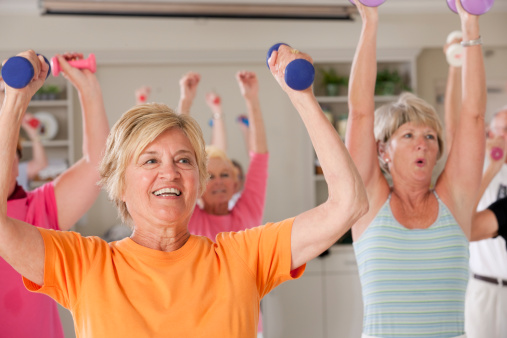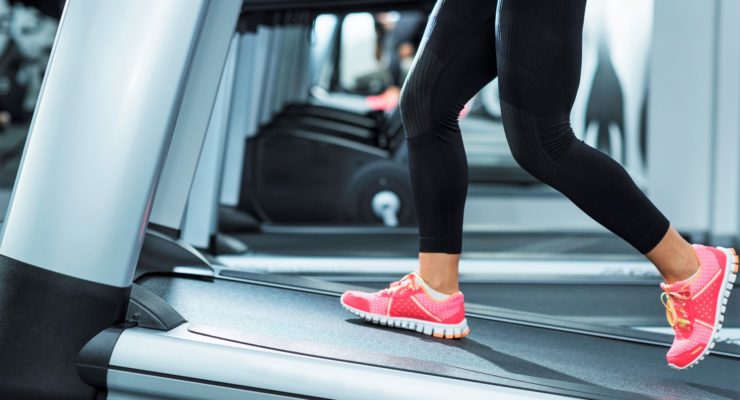Weight Lifting: Your Slim-Down Secret Weapon?
Article posted in: Fitness
You’re killing it with cardio. You’re walking the neighborhood more than a stray dog or the neighborhood watch. You’re dropping weight and tossing clothes that are just way too big on you now. Then, you hit a plateau. Or, you get bored.
Maybe you’ve already considered weight training, but decided against it when you heard the myth that it’ll make you too bulky if you’re a woman or you’re intimidated by the other guys grunting in the mirror at the gym.
But if you really want to treat your body right, lose weight and inches, you should reconsider adding resistance training to your stable of fitness fun.
Let’s take a look at some common questions we all have before starting to get our “swole on.”
What are the benefits of resistance training in addition to doing cardio?
Besides looking leaner in your jeans (one pound of fat takes up 18 percent more space than a pound of muscle!), adding strength training to your workout routine can give you a higher resting metabolic rate, which means a more muscular you burns more calories just sitting on your bum than the out-of-shape you did. So when you do sit, you are actually rewarded with more calories being tossed in the fat-burning fire.
A study, published in the Journal of Applied Physiology, shows that exercising effectiveness can depend upon the type you are doing. Researchers split study participants, who were all following the same diet, into four groups: Strength training, endurance training, combined strength and endurance training and “physical activity recommendations.” Those who combined weights with cardio were able to get their blood pumping more than the other three groups.
A Harvard study, published in 2014 in the journal Obesity, showed that men who did 20 minutes of weight training daily gained less age-related abdominal fat than others who swapped the weights for 20 minutes of cardio. A similar study published in the same journal found weight training kinder to waists on men and women. Good news considering that less belly fat means a lower risk of cardiovascular diseases like high blood pressure, heart attack or stroke.
Weight training can even up your bone density, which is important as we get older. The National Institutes of Health found that “both aerobic and resistance training exercise can provide weight-bearing stimulus to bone, yet research indicates that resistance training may have a more profound site specific effect than aerobic exercise.”
And being fit has been proven to improve your mood and lower your stress level, so while you’re lowering your risk of heart disease and cancer, you’re raising your chances of making new friends and enjoying life.
How much is optimal?
If you’ve never worked out with weights before, the American College of Sports Medicine suggests starting slowly. You should be able to complete the movement eight to 12 times (repetitions) in a set (one grouping of repetitions). If you barely eek out two or three chest presses, lower the weight and watch your form. Never sacrifice form for weight.
Experts suggest adding weights to your exercise regime twice a week and working up to three times weekly. If you decide to “pump iron” daily, be sure to only work a maximum of three muscle groups each day, so your muscles and bones have time to repair.
What if you have injuries?
Before starting any exercise program, you should always check with your doctor, but once you hit the gym, don’t let the “no pain, no gain” crowd fool you. The last thing you want to have to do have to halt your whole routine due to a serious injury. So if something hurts while you’re weight lifting, stop and get checked out.
Once the doctor gives you the “all clear,” be sure to ask if there are motions or positions you should avoid. If you still have pain, test out your range of motion to see what hurts. If you’re sore because you worked a “push” muscle too hard, try a muscle that engages when you use a pulling motion. If your gym has personal trainers on hand, ask if there are alternative exercises that won’t aggravate your injury. And just because your leg is broken, doesn’t mean you can’t lift a 10 pound free weight and do some upper body moves!
The best way to work out injury-free is to avoid being injured in the first place. The only person you are competing with is yourself, so why work out for your health only to hurt yourself by doing too much too soon? Meet with a personal trainer to set up a training program–most gyms offer one free session–and stick to it. Be sure to warm up before a work out and gently stretch while you cool down.
And believe it or not, the most important things you can do to avoid injury aren’t even done near the rowing machine: Eat right and get a good night’s sleep. Your body needs nutrients to repair itself and sleepy time to restore. Serve up an extra helping of spinach, swap your PowerFuel cheese stick for some lean chicken or turkey and hit the hay an hour earlier than you normally would.
Do you have to go to a gym to reap the benefits of resistance training?
The answer to this one is “no way!”
If your apartment doesn’t have in-unit laundry, take the steps instead of the elevator to bring your dirty clothes to the basement. Cleaning your apartment and rearranging furniture can help you work up a sweat and add muscle engagement. Pushing the grandkids on the swings in the park can engage those core muscles and tone your abs. If you’re a homeowner, shoveling snow or mowing the lawn can be a great way to build muscle while working your cardiovascular system.
Hopefully, it doesn’t snow every day, so muscle-building activities like shoveling might not be as frequent as you would like. So what do you do? Do bicep curls with soup cans?
Turns out, the only resistance you need is your own body’s resistance. Lunges, squats, taking the steps, pull-ups at the park, push-ups and crunches are all great ways to tone and tighten without a monthly membership fee.











